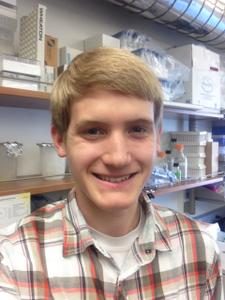NEPTUN Biography
BEN MORAN, Marine Biologist from Small-town Ohio
|
Major: Marine Biology College/Employer: NEU Year of Graduation: 2018 |

|
Brief Biographical Sketch:
I was born and raised in Minerva, a rural town about halfway between Cleveland and Pittsburgh. I've loved wildlife in general as long as I can remember, but I was always especially drawn towards marine life, maybe because it seemed so exotic living in the Midwest. I'm currently in my fifth year at Northeastern as a Marine Biology major, and so far I've worked in several labs, with projects in genetic engineering, fisheries biology, ecology, and genomics. In my free time, I play trombone and guitar, run, and make high-adventure outdoor trips whenever possible. Past Classes(Look at the class archive for more.)How to Clone a Mammoth Part 1 in Splash Spring 2018
Could extinct species, like woolly mammoths and passenger pigeons, be brought back to life? The science says yes. Should they? The jury is out.
Come learn about the frontier of biology known as de-extinction, where scientists are using the latest developments in genetics to do what was previously thought impossible. Understand the science behind the process, meet the major players making it happen, and discuss the ethical problems that need to be addressed before it's a reality.
How to Clone a Mammoth Part 2 in Splash Spring 2018
Could extinct species, like woolly mammoths and passenger pigeons, be brought back to life? The science says yes. Should they? The jury is out.
Having learned about the science behind de-extinction in Part 1, it’s your turn to decide what species can (and should) be brought back. Choose your own extinct species, receive a list of all the info relevant to its return, and make a plan for how it would be revived. A final vote by the class will decide whose species will be supported for de-extinction.
How to Build a Tree of Life in Spring Splash 2017
Biologists often group life in ways that defy our expectations: despite growing out of the ground, mushrooms are closer to humans than to plants, and two different kinds of "worms" can be farther apart than people and lobsters. How do they come up with this insanity? In this class, we'll overview the history and modern practice of the classification of life, or taxonomy. We'll discuss early attempts to make sense of our natural world, the insights brought by the theory of evolution, and how modern genetics has repeatedly turned our intuition on its head. Along the way, we'll build our own trees of life, and update them with two centuries' worth of knowledge.
Salsa con Salsa in Spring Splash 2017
Spice up your dance moves! We'll be learning the basics of salsa, a social dance popular throughout the U.S. and Latin America. We'll start from the basic step, learn some cool moves, and then end the class with some social dancing to the music of Hector Lavoe and others. Chips and salsa included!
Weird Animals in Spring Splash 2017
How do jellyfish glow? What's the real reason giraffes have such long necks? How do animals living at the bottom of the ocean survive without light or heat? This class talks about some of the strangest animals on Earth and in the oceans: how they got that way and how their weird characteristics help them thrive.
Hell on Earth: Ocean Life in the Abyssal Zone in Splash Fall 2014
While we often set stories of beautiful or horrifying aliens in outer space, you can take a much shorter trip and find these creatures here on Earth! Organisms in the deepest parts of the ocean live in frigid water, absolute darkness, and such massive pressure it can crush a styrofoam cup to the size of a thimble. To deal with these extreme conditions, abyssal life has developed equally extreme adaptations: telescoping jaws, expandable stomachs, and organic light shows, to name some tamer examples! This class will use video and visual examples of the alien adaptations of the deep sea as a springboard for discussions about the ecological and physical processes driving this adaptation, such as predator-prey interactions, optics, and hydrothermal vents; class members will actively participate as we discover what could be driving the creation of such amazing animals.
|
|
